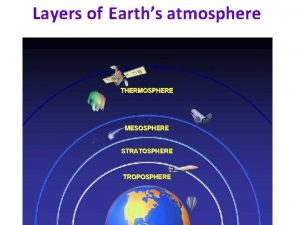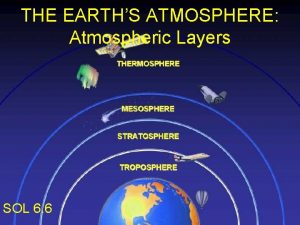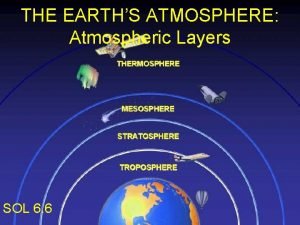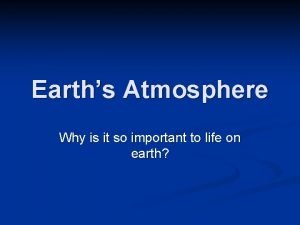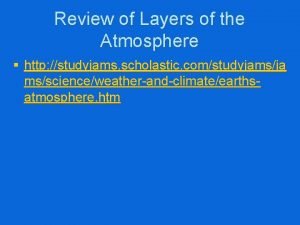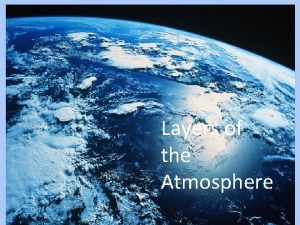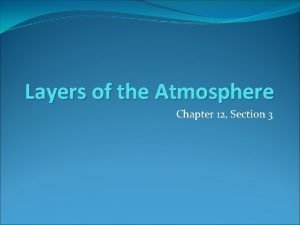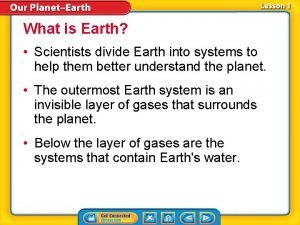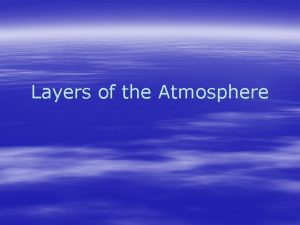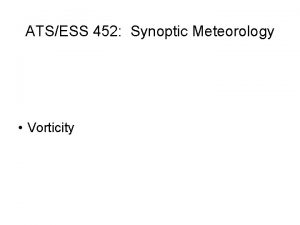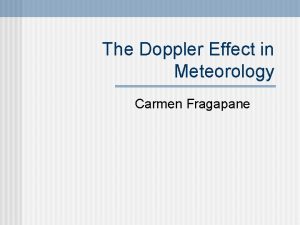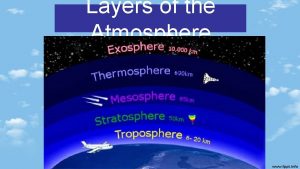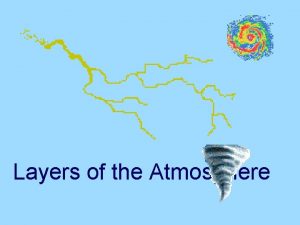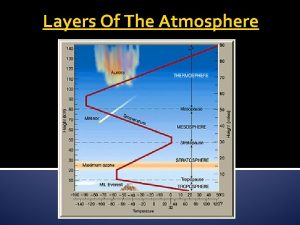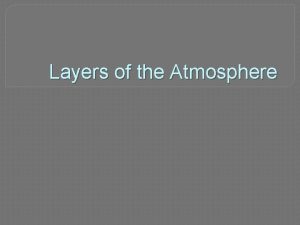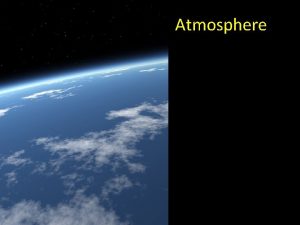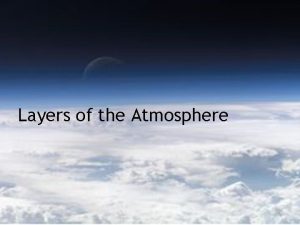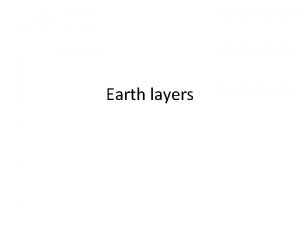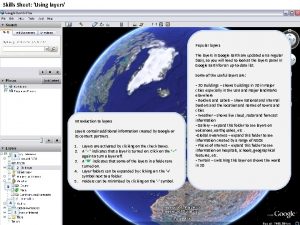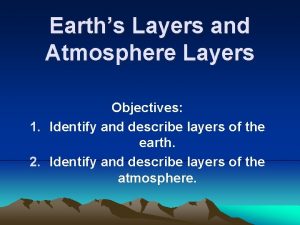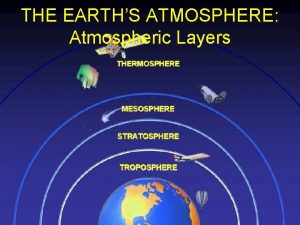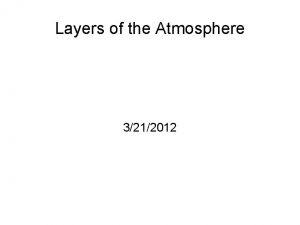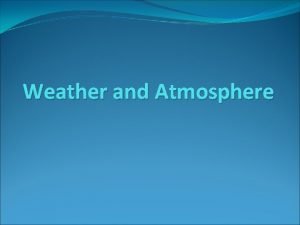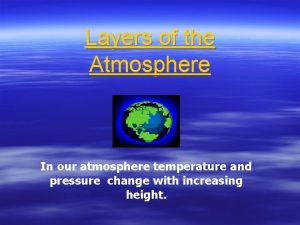Meteorology Layers of the Atmosphere Meteorology Meteorology is
























































- Slides: 56

Meteorology Layers of the Atmosphere

Meteorology § Meteorology is …

Meteorology § Meteorology is the branch of science that deals with the atmosphere of a planet, particularly that of the Earth, the most important application of which is the analysis and prediction of weather.

Kid definition § Meteorology is the study of the atmosphere to analyze and predict the weather.

Background Info § Although the density of air decreases with the increasing altitude, that is, the air gets “thinner”, the proportions of gases in the air remain relatively the same, at least in the lower layers. Water vapor is found in the atmosphere, but its concentration varies with weather and climate conditions. For example, air is generally dry over the southwestern states but relatively wet over the southeastern region, which includes the Florida Keys. § Top Ten Gases in Our Atmosphere

What are the layers of the atmosphere and how do they interact? § Detailed Look at Each (stop @ 4 mins. )

Layers of the Earth’s Atmosphere

Troposphere O to 12 km (about 7. 5 miles) tropo means -

Troposphere O to 12 km tropo means – “turning” or “changing” ___ km above the equator or less than __ km above Poles

Troposphere O to 12 km tropo means – “turning” or “changing” 12 km above the equator or less than 9 km above Poles At the top of this layer temperature stays ___ °C

Troposphere O to 12 km tropo means – “turning” or “changing” 12 km above the equator or less than 9 km above Poles. It is made mostly of the gases nitrogen and oxygen. At the top of this layer temperature stays -60 °C Water here forms ______, feathery clouds of _____

Troposphere O to 12 km tropo means – “turning” or “changing” 12 km above the equator or less than 9 km above Poles At the top of this layer temperature stays -60 °C Water here forms _thin_, feathery clouds of _ice_ ______, _______ & ______ occur in this layer

Troposphere O to 12 km tropo means – “turning” or “changing” 12 km above the equator or less than 9 km above Poles At the top of this layer temperature stays -60 °C Water here forms _thin_, feathery clouds of _ice_ _Rain_, _snow__, & _most_ _clouds_ occur in this layer The Troposphere is important because…

Troposphere O to 12 km tropo means – “turning” or “changing” 12 km above the equator or less than 9 km above Poles At the top of this layer temperature stays -60 °C Water here forms _thin_, feathery clouds of _ice_ _Rain_, _snow__, & _most_ _clouds_ occur in this layer The Troposphere is important because… weather occurs in this layer. Weather is important because it starts the water cycle.

Stratosphere ___ to ___ km (7. 5 – 31 miles) strato-

Stratosphere 12 to 50 km (about 7. 5 miles – 31 miles) strato- “layer” or “spread out”

Stratosphere 12 to 50 km strato- “layer” or “spread out” The _____ stratosphere is warmer(-20 C/-68 F) than the lower stratosphere (-60 C/-76 F) Where troposphere and stratosphere meet is the jet stream, a current of fast-moving air. In our country, the jet stream blows from west to east. It tends to push our weather in that direction.

Stratosphere 12 to 50 km strato- “layer” or “spread out” The _upper_ stratosphere is warmer(-20 C/68 F) than the lower stratosphere (-60 C/ -76 F) ____is in the middle portion of the stratosphere

Stratosphere 12 to 50 km strato- “layer” or “spread out” The upper stratosphere is warmer(-20 C/-68 F) than the lower stratosphere (-60 C/-76 F) _Ozone_is in the middle portion of the stratosphere

Stratosphere 12 to 50 km strato- “layer” or “spread out” The _upper_ stratosphere is warmer than the lower stratosphere _Ozone is in the middle portion of the stratosphere The _______ protects Earth’s living things from ______________ from sun.

Stratosphere 12 to 50 km strato- “layer” or “spread out” The _upper_ stratosphere is warmer than the lower stratosphere _Ozone_ is in the middle portion of the stratosphere. Ozone is a form of oxygen found in the atmosphere. The _ozone_layer_ protects Earth’s living things from ultraviolet radiation_ from sun. Some say there is a hole in our ozone layer. It is not exactly a hole but a thinning of the ozone layer where it is in low concentrations. Felix Baumgartner's fall from space

Mesosphere ___ to ___ km (31 -50 miles)

Mesosphere _50_ to _80_ km meso - means “_____”

Mesosphere _50_ to _80_ km meso - means “_middle_”

Mesosphere _50_ to _80_ km meso - means “_middle_” Most ______ burn up in the _____, producing ______.

Mesosphere _50_ to _80_ km meso - means “_middle_” Most _meteoroids_ burn up in the _mesosphere_, producing _meteor_ _trails_. Molecules in the air spread _____ apart.

Mesosphere _50_ to _80_ km meso - means “_middle_” Most _meteoroids_ burn up in the _mesosphere_, producing _meteor_ _trails_. Molecules in the air spread _____ apart.

Mesosphere _50_ to _80_ km meso - means “_middle_” Most _meteoroids_ burn up in the _mesosphere_, producing _meteor_ _trails_. Molecules in the air spread _farther_ apart. Temperatures approach ____⁰C

Mesosphere _50_ to _80_ km meso - means “_middle_” Most _meteoroids_ burn up in the _mesosphere_, producing _meteor_ _trails_. Molecules in the air spread _farther_ apart. Temperatures approach _-90_⁰C

Mesosphere _50_ to _80_ km meso - means “_middle_” Most _meteoroids_ burn up in the _mesosphere_, producing _meteor_ _trails_. Molecules in the air spread _farther_ apart. Temperatures approach _-90_⁰C Important in the atmosphere because…

Mesosphere _50_ to _80_ km meso - means “_middle_” Most _meteoroids_ burn up in the _mesosphere_, producing _meteor_ _trails_. Molecules in the air spread _farther_ apart. Temperatures approach _-90_⁰C Important in the atmosphere because… It protects Earth’s surface from being hit by most _________.

Mesosphere _50_ to _80_ km meso - means “_middle_” Most _meteoroids_ burn up in the _mesosphere_, producing _meteor_ _trails_. Molecules in the air spread _farther_ apart. Temperatures approach _-90_⁰C Important in the atmosphere because… It protects Earth’s surface from being hit by most _meteoroids_.

Thermosphere above __ km

Thermosphere above _80_ km This layer extends from ____ km above Earth’s surface outward into space.

Thermosphere above _80_ km This layer extends from _80_ km above Earth’s surface outward into space. It has ________ outer limit.

Thermosphere above _80_ km This layer extends from _80_ km above Earth’s surface outward into space. It has _no_ _definite_ outer limit. This layer can reach temperatures of _______⁰C.

Thermosphere above _80_ km This layer extends from _80_ km above Earth’s surface outward into space. It has _no_ _definite_ outer limit. This layer can reach temperatures of _1, 800 -2000_⁰C. (about 3200 F) Despite the high temperatures, you would ____ feel warm.

Thermosphere above _80_ km This layer extends from _80_ km above Earth’s surface outward into space. It has _no_ _definite_ outer limit. This layer can reach temperatures of _1, 800_⁰C. Despite the high temperatures you would _NOT_ feel warm. Important in the atmosphere because…

Thermosphere above _80_ km This layer extends from _80_ km above Earth’s surface outward into space. It has _no_ _definite_ outer limit. This layer can reach temperatures of _1, 800_⁰C. Despite the high temperatures you would _NOT_ feel warm. Important in the atmosphere because… The ______ extends out into _________. We view the _____ or aurora borealis.

Thermosphere above _80_ km This layer extends from _80_ km above Earth’s surface outward into space. It has _no_ _definite_ outer limit. This layer can reach temperatures of _1, 800_- 2000 ⁰C. Despite the high temperatures you would _NOT_ feel warm. Important in the atmosphere because… The _thermosphere_ extends out into _outer_ _space_ Many satellites orbit here. . We view the _Northern_ _Lights_ or Aurora Borealis, which are magnetic particles located in thermosphere.

Aurora Borealis § What causes the Northern Lights? Aurora over Hancock, MI looking north, July 25, 2004, 2: 18 am Photos by Claudia Perko From http: //www. geo. mtu. edu/weather/aurora/

Thermosphere (continued) § This layer is divided into two sub-layers. § The lower layer is called the ionosphere. – About 80 to 400 km above Earth’s surface – Northern Lights are located in this layer § The upper layer is called the exosphere. – About 400 km outward for thousands of km

Wrap Up on Atmosphere § Mr. Parr's Layers of Atmosphere Song § Tornadoes sometimes make trouble in eastern states Create your own mnemonic sentence and share it.

Summarizer § NASA The Structure of our atmosphere

Part Two What makes the wind blow? Mr. Wizard Demo 1 Where does wind come from?

Atmospheric Circulation § Atmospheric circulation on planets

Global Winds Little Shop of Science - global circulation § Global winds are the result of uneven heating. The air over the equator is warmer than the air over the poles. As a result, the hot air over the equator rises, and the cold air from the poles slips in under it. Global winds are curved by the Earth’s rotation. The direction of the earth’s rotation and its wind patterns is shown.

The Coriolis Effect § The rotation of the Earth causes and interesting phenomena on free-moving objects on Earth. Objects in the Northern Hemisphere are deflected to the right while objects in the Southern Hemisphere are deflected to the left. § Will a toilet flush opposite in Australia?

Jet Stream § How does our jet stream work?

High and Low Pressure high and low pressure convection clip § The air’s density can help you predict the weather. Scientists determine how many particles are in the air by measuring how heavy the air is. Air with more particles in it is heavier than air with less particles. The weight of this air is always pushing on us and is known as air pressure. Since cold air is more dense than warm air it is heavier and greater air pressure and forms high pressure areas. Warm air is less dense and forms low pressure areas.

Air Pressure Demo § § air pressure vs altitude Egg in a bottle Mr. Wizard Demo Exploration with air pressure

Local Winds Land Sea Breezes Explained

Sea Breeze and Land Breeze Animation of Sea and Land Breezes – Illustrate your own examples

What are air masses? Air Masses - An Introduction TWC - air masses and fronts

Fronts § Hot air and cold air mass demo

How to read a weather map
 Layers of the atmosphere
Layers of the atmosphere Layers of the atmosphere song
Layers of the atmosphere song Layers of the atmosphere song
Layers of the atmosphere song Atmosphere and its layers
Atmosphere and its layers Study jams atmosphere
Study jams atmosphere Troposphere, stratosphere, mesosphere, thermosphere
Troposphere, stratosphere, mesosphere, thermosphere The four main layers of the atmosphere
The four main layers of the atmosphere Scientists divide the atmosphere into how many layers?
Scientists divide the atmosphere into how many layers? First layer of the earth
First layer of the earth Description of earth's atmosphere
Description of earth's atmosphere Chụp tư thế worms-breton
Chụp tư thế worms-breton Tư thế ngồi viết
Tư thế ngồi viết ưu thế lai là gì
ưu thế lai là gì Voi kéo gỗ như thế nào
Voi kéo gỗ như thế nào Thẻ vin
Thẻ vin Thể thơ truyền thống
Thể thơ truyền thống Các châu lục và đại dương trên thế giới
Các châu lục và đại dương trên thế giới Từ ngữ thể hiện lòng nhân hậu
Từ ngữ thể hiện lòng nhân hậu Diễn thế sinh thái là
Diễn thế sinh thái là Lp html
Lp html V. c c
V. c c Làm thế nào để 102-1=99
Làm thế nào để 102-1=99 Chúa sống lại
Chúa sống lại Lời thề hippocrates
Lời thề hippocrates Sự nuôi và dạy con của hổ
Sự nuôi và dạy con của hổ đại từ thay thế
đại từ thay thế Vẽ hình chiếu vuông góc của vật thể sau
Vẽ hình chiếu vuông góc của vật thể sau Quá trình desamine hóa có thể tạo ra
Quá trình desamine hóa có thể tạo ra Công thức tính độ biến thiên đông lượng
Công thức tính độ biến thiên đông lượng Thế nào là mạng điện lắp đặt kiểu nổi
Thế nào là mạng điện lắp đặt kiểu nổi Dạng đột biến một nhiễm là
Dạng đột biến một nhiễm là Bổ thể
Bổ thể Vẽ hình chiếu đứng bằng cạnh của vật thể
Vẽ hình chiếu đứng bằng cạnh của vật thể độ dài liên kết
độ dài liên kết Kể tên các môn thể thao
Kể tên các môn thể thao Khi nào hổ mẹ dạy hổ con săn mồi
Khi nào hổ mẹ dạy hổ con săn mồi điện thế nghỉ
điện thế nghỉ Một số thể thơ truyền thống
Một số thể thơ truyền thống Biện pháp chống mỏi cơ
Biện pháp chống mỏi cơ Trời xanh đây là của chúng ta thể thơ
Trời xanh đây là của chúng ta thể thơ Thiếu nhi thế giới liên hoan
Thiếu nhi thế giới liên hoan Các số nguyên tố là gì
Các số nguyên tố là gì Vẽ hình chiếu vuông góc của vật thể sau
Vẽ hình chiếu vuông góc của vật thể sau Tỉ lệ cơ thể trẻ em
Tỉ lệ cơ thể trẻ em Các châu lục và đại dương trên thế giới
Các châu lục và đại dương trên thế giới Thế nào là hệ số cao nhất
Thế nào là hệ số cao nhất Hệ hô hấp
Hệ hô hấp Tư thế ngồi viết
Tư thế ngồi viết Cái miệng xinh xinh thế chỉ nói điều hay thôi
Cái miệng xinh xinh thế chỉ nói điều hay thôi Hình ảnh bộ gõ cơ thể búng tay
Hình ảnh bộ gõ cơ thể búng tay đặc điểm cơ thể của người tối cổ
đặc điểm cơ thể của người tối cổ Mật thư tọa độ 5x5
Mật thư tọa độ 5x5 Meteorology 101
Meteorology 101 Cisk meteorology
Cisk meteorology What is vorticity in meteorology
What is vorticity in meteorology Doppler effect meteorology
Doppler effect meteorology Meted ucar
Meted ucar
